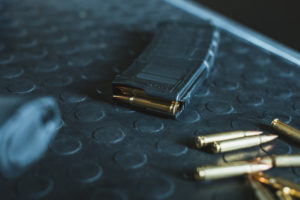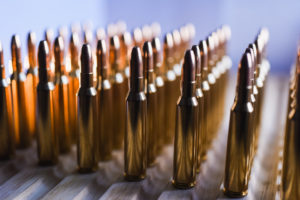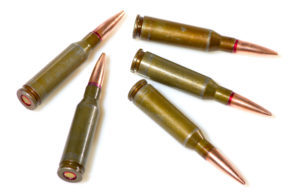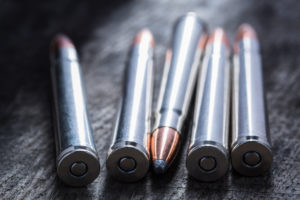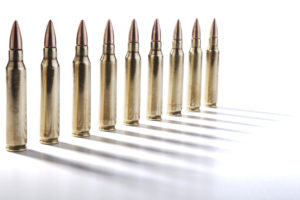Part 7: (Ammo) After you have selected your Survival Carbine, the next step is selecting the right ammunition to store and train with for emergency situations. This article will help you make sure that when it counts….you have the right ammo in your magazine.
This article is Part 7 in a series of posts.
Read Part 1: (A Little Background)
Read Part 2: (History)
Read Part 3: (Direct Gas Impingement (DI/DGI) vs. Gas Piston Operated)
Read Part 4: (Build Options)
Read Part 5: (Commercially Available Direct Gas Impingement Systems)
Read Part 6: (Commercially Available Gas Pistons Systems)
SKIP AHEAD
Ammunition Performance and Your Rifle
The baseline for your ammo choice is going to be your rifle’s barrel. What is it chambered for
The next question you want to ask is, “what is my ammo’s mission?” Will this be for training, home defense, hunting, SHTF? Ideally you would want to choose a load that satisfies all needs, but this is not always practical.
The last question you need to ask is, “am I willing to lay in the funds to stockpile my chosen load?” Hopefully you find a balance between performance and price where you can both stockpile ammo and train to maintain proficiency.
Terminal Ballistics and the 5.56mm NATO/ .223 Remington
The primary wounding mechanism for 5.56mm NATO and .223 is bullet fragmentation. The AR Rifle fires a small, high velocity bullet that turns and breaks apart when it strikes flesh. This creates a wound profile much larger than if it had passed clean through. The key to fragmentation is velocity, if a bullet is traveling too slow it will not fragment, and tumble or break into a couple pieces, making a much less dramatic wound.
Different bullets use different construction and will fragment at different velocities and in different ways. This is important when choosing your load; light varmint bullets will fragment at very long ranges but produce a shallow wound that is less likely of producing a stop (incapacitation). Heavier OTM (Open Tip Match) bullets will fragment at shorter range but produce devastating fragmentation profiles that are much more likely to produce a stop, even through cover.
Military Ball (M193, M855)
Military ball, the ammunition chosen most often for survival carbines. It is what was designed to
M193 has a 55 gr FMJ bullet that can be stabilized by 1:12 to 1:7 twists (1:7 twist is the MilSpec standard). With a 16” barrel, M193 will fragment out to 150 meters.
M855 has a heavier bullet at 62 gr and features a mild steel penetrator before the lead core. M855 is the current load used by the US Military and is identified by green paint on its tip (M855 is often called “green tip”). M855 will stabilize in a 1:9 barrel or faster. With a 16” barrel, M855 will fragment out to 95 meters.
For military ball, I suggest getting Lake City ammunition. Lake City Army Ammunition Plant produces small arms ammunition for the US Military, and lots of ammo that fail testing but are deemed acceptable for resale and are packaged and sold as XM193 and XM855. This is excellent ammunition and as close to milspec as possible.
Inspect your ammo for any large defects and shoot the closest thing to military surplus 5.56mm NATO there is. I would avoid foreign made military ball because it is made to different specs and wound profile and fragmentation range would be unknown.
Heavy Open Tip Match Bullets
While M855 is adequate ammunition for most applications including urban survival, it is mass produced military ball and
As part of the SPR program, Mk 262 was developed to increase the accuracy, improve the fragmentation profile, and increase the fragmentation range of the 5.56mm NATO round. Using a heavier 77 gr match bullet pushed to high velocity, the Mk 262 round achieved those goals and registered superior wound profile at 300 meters out of the 18” barreled SPR (Special Purpose Rifle). 77 gr Mk 262 requires a 1:8 twist barrel. Mk 262 is extremely hard to come by on the open market, but the technology should be noted.
Hornady’s TAP (Tactical Application Police) line is a premium LE and self defense ammunition designed for maximum
TAP has show to be very accurate out of most rifles. The wound profile is excellent with violent fragmentation with a short “neck” or depth of penetration before the bullet fragments and continues to penetrate deeply.
TAP gets a strong recommendation for the survival carbine, with it’s excellent performance and the availability of training ammo at a reduced cost. TAP 75 requires a 1:8 barrel to stabilize, but may work in a 1:9, it would be worth the cost of a box of 20 rounds to test it.
Imported Steel Case Ammunition
Most of this ammo is made in Russia and has a polymer coated case. It’s usually found in 55 gr
FMJ or hollow point with a copper jacket or more often mild steel with a copper wash jacket. This is the cheapest ammo possible, and many people shoot it for training and for recreation.
It is known to be underpowered even for .223 spec and does not fragment. This ammo is not a top choice for the survival carbine. When ammo prices are high, this may be a means to keep shooting, but don’t let this become your survival stockpile.
While this ammo will certainly work as a last resort, we win by inches, not miles, and need every advantage possible, and quality ammo is an advantage you should afford yourself.
Other Calibers
7.62x39mm
7.62×39 performs a lot like an underpowered battle rifle round. Ballistically, it follows a football shaped arc, and terminal performance does not rely on fragmentation. Most Russian made bullets penetrate deeply, turns base first, and continues to penetrate.
Wound profile does not exhibit the gross damage that fragmentation based wound exhibit. Deep penetration is the sole advantage of the 7.62×39 round. There are premium rounds with JSPs (Jacketed Soft Point) that will exhibit a larger wound profile and still retain deep penetration.
These are much more expensive than the steel cased Russian rounds, but terminal performance is greatly improved. Hornady also makes a steel cased round with a 123 gr V-MAX bullet. This is a fragmenting bullet but with limited penetration. Testing shows a huge wound profile but less than 15” of penetration from a 18.5” barrel. Expect this penetration to reduce even more when shooting through cover and with shorter barrels.
5.45x39mm
The 5.45×39 is essentially a 7.62×39 necked down to fire a 5.45 caliber bullet. The Russian bullet designs are not a fragmenting design, the bullets deform and turn creating two wound cavities and a long penetration trail.
This is not a particularly effective wound mechanism, but does not rely on velocity to inflict trauma, so barrel length and range do not make a huge difference on hits. Most ammo is corrosive, especially surplus, so clean accordingly.
AR pattern rifles are often treated to prevent corrosive gases from causing damage to the rifle. Hornady also offers a V-MAX load for the 5.45×39, but with poor penetration. If you do not plan on encountering any barriers it may be a good load, but it seems to be stuck in a very narrow portion CQB (Close Quarters Battle) role.
I would like to see a OTM load for the 5.45×39, I think there is potential for a TAP 75 type round, but at this time there is no commercial load available. There are various Russian loads available, some surplus and some new manufacture, with some bullets purported to possibly break along the cannelure and some more likely to deform at the tip and tumble. The Russian 7N6 bullet has a hollow tip and a steel perpetrator, making it the best general purpose round for the 5.45×39, with the most reliable performance at all ranges.
6.8mm SPC
6.8 SPC (Special Purpose Caliber) was designed from the ground up to perform better than 5.56 NATO and to complement the Mk 12 SPR (Special Pupose Rifle). It’s an intermediate caliber rifle cartridge that fires MOA or better from 100 to 600 meters with accuracy that is on par with than 77gr Mk 262.
6.8 SPC will travel a similar ballistic path as the heavy 5.56 NATO rounds, and recoil impulse is also similar. Ammo is definitely more expensive, but the trade-off for your dollar is a better performing round.
There are about a dozen good bullets loaded for the 6.8 SPC, some of which are good for taking game in North America, but not all are readily available. The most popular and widely available loads are going to be the Hornady 110 gr OTM and Remington 115 gr Core Lokt JSP.
The Hornady 110 gr OTM is a good fragmenting load that has a good wound profile and good barrier penetration compared to other loads. The wound profile is still rather good even when the bullet doesn’t fragment, and penetration meets or exceeds the FBI minimum 12” recommendation.
The Remington 115 gr JSP (Jacketed Soft Point) performs like a medium sized rifle JSP and is a good barrier round. It’s also a good hunting round for medium and large game. The JSP is expensive and not something I would chose as a primary load.
6.8 SPC ammo is expensive in general and may be a mission specific weapon system in your survival toolkit. I can see a 6.8 SPC SPR or a 6.8 SPC PDW (Personal Defense Weapon) being great platforms for this caliber. The drawbacks to this caliber would possibly be the limited availability compared to 5.56/.223 and 7.62×39.
6.5mm Grendel
This is an intermediate cartridge developed by Bill Alexander of Alexander Arms and is an improved version of the PPC (Palmisano & Pindel Cartridge). The 6.5 Grendel cartridge was designed as a low recoil, high accuracy, long-range cartridge for the AR-15 platform.
The name “6.5 Grendel” is a trademark owned by Alexander Arms. Les Baer Custom has released a new cartridge known as the 264 LBC-AR which uses the same cartridge case, but has different chamber dimensions from those using the “6.5 Grendel” brand.
Supporters claim that the Grendel is an ideal middle ground between the 5.56 mm NATO and the 7.62 mm NATO, taking the best aspects of each one. It has a reported flatter trajectory and retains greater terminal energy at extended ranges than either of these cartridges due to its higher ballistic coefficient.
Production rifles have consistently achieved sub-minute of angle (MOA) groups at test ranges out past 600 meters. Hunting with the 6.5 Grendel is a great option and premium hunting 6.5 mm bullets that are available including Nosler Partitions, Nosler Ballistic Tips, Swift A-Frame and Swift Scirrocco to mention a few, all work from the magazine.
Shooters have already been using the Grendel to great success on Deer, Hogs, Antelope, and Coyotes. Once again, the availability and surplus of these types of rounds will be lower than 5.56 and 7.62 due to 6.5 current limited use and production, in relation to the standard military and law enforcement rounds that have been in worldwide use for decades.
Continue Reading Part 8: The Conclusion
Also read Mr. Smashy’s Classic Series – Survival Shotgun – 6 Reasons You Need One


